Hey Guys!
The demand for ecommerce is booming, with global ecommerce sales projected to reach $6.56 trillion by 2025, accounting for nearly 24% of total retail sales worldwide. Businesses that fail to adapt to digital transformation risk losing their market share.
To stay competitive, companies must build node js ecommerce website that is fast, scalable, and high-performing—essential factors for today’s online shoppers. Studies show that a one-second delay in page load time can reduce conversions by 7%, making performance a key priority.
This guide will walk you through the best strategies to build ecommerce website node js, covering:
- MEAN/MERN stacks for rapid development
- Microservices architecture for scalability
- Step-by-step development guide
Key Takeaways On Building Node js Ecommerce Website
- MEAN/MERN is a great option for startups – It allows rapid development, scalability, and a seamless front-end experience for an e commerce Node js website.
- Microservices help in scaling – Enterprises can break down complex applications into independent services, improving flexibility and performance.
- Performance and speed – Node.js is event-driven and non-blocking, processing requests 50% faster than traditional technologies, making it ideal for high-traffic eCommerce platforms.
- Customization and flexibility – Both approaches allow for custom eCommerce solutions, integrating essential third-party tools and APIs.
- Proven technology – Global brands like eBay and Walmart leverage Node.js for their high-performing ecommerce systems.
Is Node js Good For Ecommerce?
- Speed & Performance: The V8 engine powers Node.js, ensuring faster execution and non-blocking I/O operations.
- Scalability: Supports handling high-traffic loads efficiently, making it perfect for growing businesses.
- Cross-Platform Development: Enables development of web, iOS, and Android applications with a single codebase by 30%
- Real-Time Processing: Supports instant updates, making it ideal for online transactions and inventory management.
- Microservices Compatibility: Allows for independent service scaling and flexibility in development.
To work on Node.js ecommerce websites, MEAN/MERN are considered excellent choices, especially in the early stages of a business.
However, as the Node js ecommerce website grows and needs to handle an unprecedented number of users worldwide, Microservices become essential. We’ll explore Microservices in more detail shortly.
Option 1: Build Ecommerce Website Node js Using MEAN/MERN
Many businesses prefer build node js ecommerce website with MEAN (MongoDB, Express.js, AngularJS, Node.js) or MERN (MongoDB, Express.js, React.js, Node.js) stacks. These technologies ensure faster execution, real-time updates, and better performance.
Is MEAN/MERN a Good Choice?
The ability to respond quickly and efficiently to sudden traffic surges is one of the strongest advantages of the MEAN/MERN stack. Without a doubt, it is an excellent option for any eCommerce web application in its early stages or just rolling out.
What Exactly Does the MEAN/MERN Stack Consist Of?
- MongoDB: A NoSQL database that manages data exchange and execution, assisting Node.js in running the server smoothly.
- ExpressJS: A backend web framework that provides a simple and seamless interface for building web applications.
- AngularJS/ReactJS: AngularJS enables automatic view/model synchronization for web development, while React is a JavaScript library rather than a full-fledged framework.
- Node.js: A JavaScript runtime built on Chrome’s V8 engine, known for its lightweight, efficient, event-driven, and non-blocking I/O model.
Why Choose MEAN/MERN Ecommerce with Node js?
- Performance: Node.js is well-suited for asynchronous, I/O-heavy workflow applications 2x faster than traditional stacks and event-driven applications.
- Scalability: The non-blocking I/O model, coupled with the V8 engine, helps maximize CPU utilization handling thousands of concurrent users.
- Efficient Frontend (Fully Customizable): Frontend operations run on the client side, improving performance and faster user experience.
- No Licensing (Truly Open Source): The MEAN stack is fully open source, eliminating licensing fees and providing easy access to public repositories and libraries.
- PWA (Progressive Web App) Ready: MEAN/MERN supports PWAs, which function similarly to native applications without requiring App Store access.
- Real-Time Response: Socket.io in Node.js facilitates instant updates, such as product quantity and pricing, using reactive frameworks like AngularJS and ReactJS.
- Better User Experience: Real-time updates without page reloading enhance the eCommerce shopping experience.
- Proven and Widely Used Technology: MEAN/MERN is adopted by startups and enterprises alike, including eBay, Facebook, and Google.
- Universal Programming Language: JavaScript is one of the most popular, scalable, and high-performance programming languages, offering limitless customization possibilities.
🛒 Did You Know? Studies show that eCommerce businesses with fast, interactive web applications experience a 35% higher conversion rate. That’s why global brands like eBay, and Walmart leverage MEAN/MERN stacks!
Option 2: Build Website Node js Platform with Microservice Architecture
Node.js complements Microservices when building commerce web applications.
Instead of using applications that require costly and frequent maintenance, businesses can deploy a Microservices-based eCommerce application that integrates everything via APIs. This architecture effectively breaks down complex processes into small, independent services.
Proper utilization of Microservices empowers various services across Node js eCommerce platforms, allowing them to scale and update independently.
What does Microservices for eCommerce mean?
Many business owners who initially used the MEAN/MERN stack for their web applications faced challenges, including:
- Managing multiple APIs across various categories and subcategories
- Repetitive application crashes
- High maintenance costs
Microservices to the rescue! This architecture enables efficient management of code-based services, databases, and programming languages—all independently.
Node js Website Example: eBay adopted Microservices in Node.js and improved its website response time by 50%, setting a benchmark in eCommerce scalability.
Why Are Microservices Preferred for Node.js eCommerce?
1. Heavy Front-End Traffic Does Not Affect Back-End Servers
One of the biggest advantages of Microservices is the ability to scale frontend and backend separately. Developers can extend services only where needed, ensuring backend operations remain unaffected by high frontend traffic.
2. Greater Scope for Customization and Personalization
With multiple frontends connected to a single backend, businesses have more opportunities to add new touchpoints and enhance the user experience.
3. Faster Implementation with a Flexible Tech Stack
Thanks to a decentralized development process, different teams can collaborate more easily, adjust code bases efficiently, and reduce bringing products time-to-market faster by 50%.
4. Only Pay for What You Need
Unlike all-in-one systems that offer unnecessary features, Microservices allow businesses to implement only the functionalities they require. This results in a leaner, more efficient technology stack with lower costs.
5. Best-in-Class Solutions
A vendor-agnostic approach enables businesses to choose specialized services and providers that align precisely with their needs—without relying on a single system.
Webnexs: Your Affordable Microservices Solution
Webnexs offers businesses the flexibility, scalability, and affordability needed to build a powerful ecommerce platform using Node.js and Microservices at an affordable cost.
Step-by-Step Guide to Build a Node.js eCommerce Website
STEP 1 – Start with Agile Software Development
Ecommerce business owners frequently enhance their Apps, making iterative development essential.
The Agile software development model is the best approach for a Node js ecommerce project. 80% of ecommerce businesses use Agile development to improve efficiency and iterate on user feedback faster.
STEP 2 – Assemble a Competent Team
A skilled development team should include:
- Business analysts
- UI/UX designers
- Node.js developers
- Testers
- A project manager (PM)
Note: Infrastructure architects or cloud platform architects are not required.
Pro Tip: Hiring a skilled Node js eCommerce project team reduces launch delays by 40%.
STEP 3 – Choose a PaaS Provider
We recommend Heroku PaaS to manage key aspects like the operating system, third-party integrations, and servers. It allows the development team to focus on coding while handling scalability and application management.
🚀 You’re halfway there—keep going!
STEP 4 – Download and Install Node.js
Follow these steps to install Node.js:
- Visit the Node.js download page for platform-specific installers.
- Use the Node Package Manager (NPM) to install Node.js.
- Refer to the JS package manager documentation for platform-specific guidance.
STEP 5 – Use a Proven Node.js eCommerce Framework
A lean framework from Webnexs ensures:
- Faster go-to-market
- Less time spent on complex problems
- Easier upgrades
With Node.js systems for eCommerce, businesses can build scalable and efficient applications seamlessly.

Webnexs offers a lean, scalable ecommerce website in node js that ensures faster deployment and long-term growth.
Wrapping Up
By leveraging Node.js, businesses can build ecommerce website with Node js that is scalable, high-performing, and adaptable to market changes.
Whether using MEAN/MERN or Microservices, Node.js provides the flexibility and power required for modern eCommerce platforms. MEAN/MERN stacks are ideal for startups, while Microservices suit enterprise-level applications.
Webnexs specializes in eCommerce website Node.js development, offering ready-built solutions for businesses aiming for long-term success.
Need expert guidance? Let Webnexs help you bring your vision to life. Contact us today!



